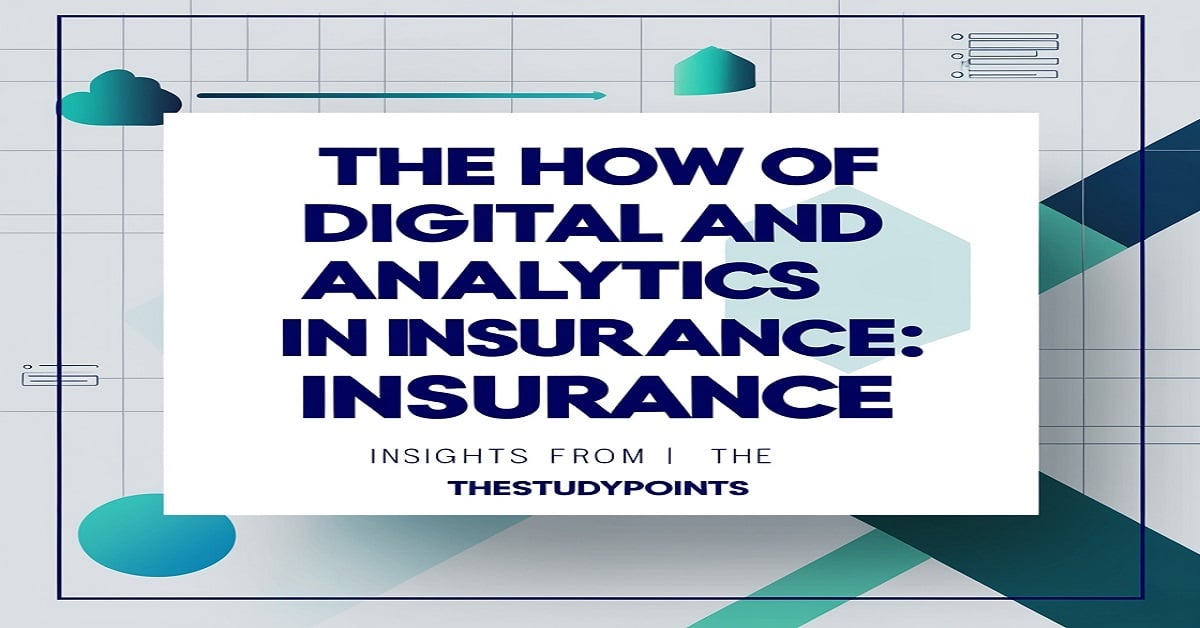In the rapidly evolving insurance industry, digital technologies and analytics are no longer optional—they are essential drivers of efficiency, competitiveness, and customer satisfaction. Insurers are leveraging these tools to improve their operations, personalize customer experiences, enhance risk management, and streamline claims processes.
This blog post dives deep into the how of digital and analytics in insurance, exploring how these innovations are transforming the industry, and how insurers can capitalize on them for better results.
| Topic | Fact/Figure | Impact |
|---|---|---|
| Insurance Industry’s Digital Spend | $5.7 billion is projected to be spent on digital transformation by global insurers in 2025. | Increased investment in digital technologies improves operational efficiency and customer satisfaction. |
| Fraud Detection Savings | Machine learning systems in insurance fraud detection can reduce fraud-related losses by up to 30%. | Helps insurers save billions annually by detecting and preventing fraudulent claims. |
| Claims Processing Time Reduction | Automation can reduce claims processing time by up to 70%. | Faster claims processing leads to improved customer satisfaction and reduced operational costs. |
| Personalized Insurance Growth | 55% of consumers expect their insurers to offer personalized insurance policies based on their behavior and lifestyle. | Data-driven product development is vital to meeting customer expectations and enhancing customer loyalty. |
| Usage-Based Insurance (UBI) | The global UBI market is expected to reach $65.2 billion by 2027, growing at a 19% CAGR from 2020 to 2027. | UBI offers flexibility and personalization, growing in popularity due to IoT devices. |
| Smart Home Devices Adoption | 28% of homeowners are expected to use smart home sensors by 2025 for risk mitigation and loss prevention. | IoT in insurance helps reduce risks and enables proactive loss prevention strategies. |
| Blockchain Adoption in Insurance | 15% of insurance firms are expected to have integrated blockchain technology by 2025. | Blockchain enhances transparency, reduces fraud, and streamlines claims processing. |
| AI in Underwriting Efficiency | 75% of insurance firms report that AI and machine learning have significantly improved their underwriting processes. | AI speeds up decision-making, enhances risk accuracy, and helps create dynamic pricing models. |
| Operational Costs Savings | Insurers that leverage AI-powered automation see operational cost savings of up to 30%. | Automation leads to cost-efficiency, allowing insurers to allocate resources to other strategic areas. |
| Customer Expectations for Digital | 67% of customers prefer to manage their insurance via digital channels such as mobile apps and online portals. | Meeting customer demand for digital engagement is crucial to increasing customer satisfaction. |
| Global Insurance Data Breaches | 53% of global insurers experienced cybersecurity breaches related to customer data in the past 3 years. | Data protection is a priority, driving investment in cybersecurity to safeguard customer data. |
| Telematics Adoption in Auto Insurance | 25% of auto insurers are expected to offer telematics-based policies by 2026, driven by IoT technology in vehicles. | Telematics allows for usage-based insurance, adjusting premiums based on real-time driving data. |
| Predictive Analytics Growth | The predictive analytics market in insurance is expected to grow at a 21% CAGR from 2021 to 2026. | Predictive analytics helps insurers make data-driven decisions, improving risk management and pricing. |
Enhancing Customer Experience through Digitalization
The Digital Transformation of Insurance
The customer experience has always been at the heart of the insurance business. However, in today’s fast-paced, digital-first world, expectations have shifted dramatically. Customers now demand convenience, personalization, and instant service. Digital platforms, such as mobile apps and online portals, are essential in meeting these demands, offering policyholders access to real-time data, easy claims filing, and personalized services at the click of a button.
Personalization Through Data Analytics
Data-driven strategies are helping insurers craft personalized offerings for customers. By analyzing vast amounts of customer data, insurers can tailor insurance products to individual needs. Advanced behavioral analytics tools allow companies to segment their customer base more effectively, offering them customized products based on their specific needs, behaviors, and preferences.
For instance, usage-based policies are growing in popularity, where customers pay premiums based on their usage patterns, such as driving habits for auto insurance or energy consumption for home insurance. This shift towards personalization is made possible by predictive modeling and machine learning, which can predict customer behaviors with remarkable accuracy.
The Role of AI and Automation in Customer Engagement
The use of artificial intelligence (AI) and chatbots/virtual assistants is revolutionizing customer service in insurance. By automating basic tasks like answering inquiries or assisting with policy management, insurers can deliver faster and more efficient customer support. Moreover, AI-powered systems are capable of analyzing customer sentiments and tailoring responses to provide a more engaging, human-like experience.
Advanced Risk Assessment and Underwriting
Predictive Risk Assessment
Traditionally, risk assessment and underwriting were based on relatively limited data, often resulting in delayed decisions and less accurate pricing models. Today, digital tools have dramatically improved these processes. With access to real-time data from IoT devices, telematics, and wearable technology, insurers can gather much more comprehensive information about a customer’s lifestyle, behavior, and risk factors.
For example, smart home sensors can monitor for hazards like water leaks, fire risks, or break-ins, while wearable devices track health metrics such as heart rate, steps taken, and sleep patterns. This wealth of data allows insurers to more accurately assess a customer’s risk profile and offer personalized pricing or premiums based on real-time behaviors and conditions.
AI and Machine Learning in Underwriting
AI and machine learning are now integral parts of the underwriting process. These technologies can analyze large datasets faster and more accurately than traditional methods, enabling predictive modeling for better risk evaluation. AI algorithms can learn from historical data, identify patterns, and continuously improve their predictive capabilities, helping underwriters make faster and more informed decisions.
Additionally, automation is streamlining the underwriting workflow by removing manual tasks, such as data entry and document verification, leading to greater efficiency and fewer errors.
Proactive Loss Prevention and Risk Management
Leveraging IoT and Real-Time Data
One of the most significant impacts of digitalization on insurance is the shift from reactive to proactive risk management. With IoT devices like smart sensors, insurers can continuously monitor and assess risks in real time. For example, connected car technologies enable insurers to track driving behavior (e.g., speed, braking patterns), allowing them to offer discounts to safe drivers and adjust premiums based on driving habits.
At home, smart home devices can alert policyholders to potential risks such as gas leaks, water damage, or fire hazards before they lead to significant losses. This continuous flow of real-time data allows insurers to provide proactive loss prevention advice, which ultimately reduces claims and lowers costs.
Predictive Analytics for Risk Mitigation
By utilizing predictive analytics, insurers can forecast potential claims before they occur. Analyzing historical data, weather patterns, and other external factors can help insurers identify high-risk areas and take preventative measures. For instance, if a region is prone to wildfires, insurers can advise homeowners to install fire-resistant materials or clear vegetation around their homes to mitigate risks.
Streamlining Claims Processing with Automation
The Efficiency of AI and Automation
In the traditional insurance claims process, customers often face delays, paperwork, and long wait times for claims approval. However, automation has significantly improved this aspect of the business. Insurers are now using AI and automation tools to process claims more quickly and accurately.
For example, when a claim is submitted, AI systems can automatically validate the claim details by cross-referencing it with existing records, such as policyholder data, previous claims, and external data sources. This reduces human intervention and accelerates the approval process, allowing insurers to resolve claims faster and with fewer errors.
The Benefits of Automated Claims Systems
| Benefit | Impact on Insurers |
|---|---|
| Speed | Claims can be processed much faster, reducing the time to settlement. |
| Accuracy | AI-driven systems reduce human error, leading to more accurate claim assessments. |
| Cost Efficiency | Automation reduces operational costs associated with manual claims processing. |
| Customer Satisfaction | Faster claim resolution improves the overall customer experience and satisfaction. |
Fraud Detection and Prevention
Machine Learning for Fraud Detection
Insurance fraud is a significant challenge for the industry, costing billions each year. Machine learning algorithms are increasingly being used to detect fraudulent activities by analyzing patterns and anomalies in claims data. These tools can identify suspicious behaviors or inconsistencies in claim submissions, such as claims made in unusually high frequency or for unusual types of damages.
Real-Time Fraud Monitoring
By integrating big data sources, insurers can now track claims in real time and prevent fraudulent claims before they escalate. For instance, AI systems can analyze historical data from previous fraud cases, continuously learning and adapting to new fraud tactics.
Data-Driven Product Development and Pricing
Data-Driven Insurance Products
Data integration allows insurers to create more personalized insurance products that are based on real customer data. By analyzing customer demographics, behaviors, and preferences, insurers can identify gaps in the market and develop new products to meet evolving needs. For example, the rise of the gig economy has led to the development of flexible usage-based insurance models tailored to part-time drivers or freelancers.
Dynamic Pricing Models
Using predictive modeling, insurers can implement dynamic pricing, adjusting premiums in real time based on changes in a policyholder’s risk profile. For instance, a driver who demonstrates safe driving habits may see a reduction in their premiums, while a customer who installs new home security devices may benefit from a discount.
Overcoming Challenges in Digital Transformation
Tackling Legacy Systems
While digital transformation offers significant benefits, many insurers still rely on outdated legacy systems that make it difficult to implement new technologies. Modernizing these systems can be time-consuming and expensive, but it is essential for insurers to remain competitive and agile in the digital age.
Cybersecurity and Data Protection
With the increasing reliance on digital platforms and data analytics, insurers face growing challenges related to data protection and cybersecurity. Protecting sensitive customer data from cyber threats is crucial, and insurers must invest in robust security measures to safeguard their operations and customers’ personal information.
The Future Landscape of Digital Insurance
Emerging Technologies and Trends
The future of insurance is undoubtedly digital. As blockchain technology and AI-powered systems become more advanced, insurers will have new opportunities to enhance transparency, streamline operations, and reduce fraud. Blockchain, for example, could revolutionize how insurers handle claims, enabling smart contracts and decentralized claims processing that eliminate intermediaries and reduce administrative costs.
The growing adoption of IoT devices will continue to reshape how insurers assess risk, while AI and machine learning will enable more accurate and dynamic pricing models. Insurtech startups are also pushing the boundaries of innovation, collaborating with traditional insurers to bring cutting-edge solutions to market.
Preparing for the Future
Insurers must continuously innovate and embrace these emerging technologies to stay relevant. The future of the industry will be shaped by those who can harness the power of data-driven strategies, automation, and AI to deliver better products, services, and customer experiences.
FAQs
How are digital technologies transforming the insurance industry?
Digital technologies are transforming the insurance industry by enhancing customer experience, improving risk management, and streamlining processes. AI, machine learning, IoT devices, and automation are being used for predictive analytics, personalized insurance policies, proactive loss prevention, and faster claims processing. These technologies also help insurers reduce costs, enhance operational efficiency, and provide more accurate pricing models.
What role does data analytics play in improving customer experience?
Data analytics plays a crucial role in personalizing the customer experience. By analyzing vast amounts of customer data, insurers can offer tailored products based on individual behaviors, needs, and preferences. This leads to more relevant insurance products, such as usage-based policies, and improves customer engagement. Predictive analytics also helps insurers anticipate customer needs and respond proactively.
How does AI help with underwriting and risk assessment?
AI and machine learning improve underwriting by enabling insurers to analyze large datasets and identify patterns to predict future risks. These tools allow for faster and more accurate decisions, reducing errors and improving risk assessments. With access to real-time data from sources like IoT devices and wearables, insurers can dynamically adjust premiums based on a customer’s actual behaviors and risk profile.
How does automation speed up the claims process?
Automation speeds up the claims process by automating routine tasks such as claim validation, data entry, and document processing. AI-powered systems can analyze claims data and verify details, reducing the need for manual intervention. As a result, insurers can process claims faster, reduce errors, and enhance customer satisfaction by providing quicker resolutions.
What are the benefits of using IoT devices in insurance?
IoT devices, such as smart home sensors and connected car technology, allow insurers to monitor real-time data and assess risks more accurately. For example, smart sensors in homes can detect water leaks or fire hazards, allowing for proactive risk management. Telematics in cars can track driving behavior and enable usage-based policies, where customers pay based on how much or how safely they drive. This data-driven approach leads to more personalized, fair pricing.
How can AI help prevent insurance fraud?
AI is an essential tool in detecting and preventing insurance fraud. Machine learning algorithms can analyze claims data and detect unusual patterns or anomalies that suggest fraudulent activity. By continuously learning from historical data, these systems become more effective at identifying suspicious behavior and preventing fraudulent claims before they are processed, saving insurers millions in potential losses.
What are dynamic pricing models in insurance?
Dynamic pricing models in insurance use predictive analytics and real-time data to adjust premiums based on individual customer behavior or changing circumstances. For example, in auto insurance, a safe driver may receive a lower premium based on their driving habits, which are monitored via telematics. This approach allows insurers to offer more personalized pricing while rewarding good behaviors and mitigating risks.
How does blockchain technology benefit the insurance industry?
Blockchain technology offers several benefits to the insurance industry, primarily by improving transparency and reducing fraud. By creating immutable records of transactions, blockchain enables insurers to track claims, verify policies, and settle transactions more securely. Smart contracts can automate claims processing, reducing administrative costs and increasing efficiency. Blockchain also enhances data security, ensuring that sensitive customer information is protected.
What challenges do insurers face when adopting digital technologies?
One of the biggest challenges insurers face is overcoming legacy systems, which are often outdated and incompatible with new digital tools. The cost and time required to modernize these systems can be significant. Additionally, data protection and cybersecurity are critical concerns, as insurers handle sensitive personal and financial information. There is also the need for a skilled workforce capable of managing and leveraging these new technologies, which can require significant investment in workforce transformation.
How does AI improve customer engagement in the insurance industry?
AI-powered systems, such as chatbots and virtual assistants, help improve customer engagement by offering instant support and personalized recommendations. AI can analyze customer interactions and preferences, providing tailored responses that make the experience more engaging. By automating routine inquiries and claims processing, AI frees up human agents to focus on more complex customer needs, improving overall satisfaction.
What is the future of digital transformation in the insurance industry?
The future of digital transformation in the insurance industry is centered around continued innovation and the integration of emerging technologies like blockchain, AI, and IoT. As insurers continue to adopt data-driven strategies, we can expect more personalized insurance products, faster claims processing, and better risk management. The industry will also see further collaboration with insurtech startups, creating a more dynamic and tech-savvy marketplace.
How do IoT and AI contribute to proactive loss prevention?
IoT devices continuously monitor real-time data, such as smart home sensors and connected cars, alerting insurers and customers to potential risks before they result in significant losses. AI helps by analyzing this data to predict future risks and suggest preventive measures. For instance, AI algorithms can forecast weather events, assess property risks, and advise policyholders on mitigation actions, reducing the likelihood of claims.
Conclusion
Digital and analytics tools are transforming the insurance industry at an unprecedented rate. From improving customer experience and streamlining claims processing to enhancing risk management and fraud detection, these technologies are reshaping the way insurers operate. However, as the industry continues to evolve, insurers must remain agile and invest in the latest digital technologies to stay ahead of the competition and meet the growing expectations of their customers.
By embracing predictive analytics, IoT devices, AI, and other cutting-edge technologies, insurers can enhance operational efficiency, reduce costs, and provide more personalized, customer-centric services. As the digital landscape continues to evolve, the insurers who prioritize innovation and adaptability will thrive in the next generation of insurance.









